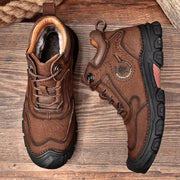Winter Wear-resistant Ankle Mountaineering Boots
SKU: 241204002-01
Collections:Men Boots, Men Dresses Shoes
Hurry, low quantity!Hurry! – Only 81 left in stock.
Mountaineering Boots
Hiking boots are a type of boot designed specifically for mountaineering activities and are designed to provide adequate support, protection and comfort to handle a variety of difficult terrain and climate conditions. These boots are typically sturdier than regular hiking boots and are compatible with climbing gear such as crampons for improved grip and stability on ice, snow or rocky surfaces.
- Upper Material : Cow Leather
- Shaft Material : Split Leather
- Outsole Material : Rubber
- Insole Material : EVA
- Boot Type : Chelsea Boots
- Toe Shape : Round Toe
| Size | Heel to Toe |
|---|---|
| 38 | 9.45 inch / 24.0cm |
| 39 | 9.65 inch / 24.5cm |
| 40 | 9.84 inch / 25.0cm |
| 41 | 10.04 inch / 25.5cm |
| 42 | 10.24 inch / 26.0cm |
| 43 | 10.43 inch / 26.5cm |
| 44 | 10.63 inch / 27.0cm |
| 45 | 10.82 inch / 27.5cm |
















When it comes to outdoor footwear, the importance of durability, comfort, and functionality cannot be overstated. The Winter Wear-resistant Ankle Mountaineering Boots are a premium choice for individuals who value performance and quality in challenging environments. Designed to meet the demands of both mountaineering and outdoor work, these boots excel in providing warmth, protection, and style.
Features
Hiking boots are designed with a variety of factors in mind, including:
Materials: Hiking boots are typically made from leather, synthetic or hybrid materials that offer good durability and water resistance.
Warmth: Depending on the season of use, hiking boots can have different warmth properties. Summer hiking boots are generally not suitable for winter use because they may not provide enough warmth.
Stiffness: Hiking boot soles are typically stiffer than hiking boots to provide better support and stability while climbing.
Fit: Many hiking boots are designed to be used with crampons, which makes them excellent on icy terrain.
Usage context
When choosing hiking boots, users need to consider their type of activity and environment. For example, for more technical climbs, specialized hiking boots would be more suitable, while for easier hikes, you might opt for lighter hiking boots.
Some climbers choose to wear hiking boots before reaching technical terrain and then switch to hiking boots for added comfort.
In short, hiking boots are an indispensable piece of equipment for mountaineering activities, and choosing the right boots is crucial to ensuring safety and comfort.























